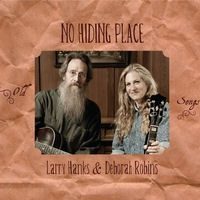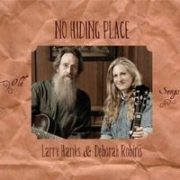LARRY HANKS DEBORAH ROBINS NO HIDING PLACE
TITLE: NO HIDING PLACE: OLD SONGS
ARTIST: LARRY HANKS AND DEBORAH ROBINS
LABEL: ZIPPETY WHIPPET MUSIC
RELEASE DATE: 2010
 Marilyn Chambers did the X-Rated version; Charlie Rich did the R-Rated adaptation (When We Get Behind Closed Doors); but to enjoy the family friendly PG-Rated version come home to Larry Hanks and Deborah Robins’ new CD, No Hiding Place, an album of quintessential traditional and modern folk songs, including Green Door, a 1957 US hit by Jim Lowe (written by Bob Davie and Marvin J. Moore in 1956), and a hit in the UK as well by three different artists, which inspired the adult film Behind the Green Door.
Marilyn Chambers did the X-Rated version; Charlie Rich did the R-Rated adaptation (When We Get Behind Closed Doors); but to enjoy the family friendly PG-Rated version come home to Larry Hanks and Deborah Robins’ new CD, No Hiding Place, an album of quintessential traditional and modern folk songs, including Green Door, a 1957 US hit by Jim Lowe (written by Bob Davie and Marvin J. Moore in 1956), and a hit in the UK as well by three different artists, which inspired the adult film Behind the Green Door.
Sex sells, but one does not expect it to sell records by old-time singer Larry Hanks and his wife Deborah Robins. So let’s just say their tongue-in-cheek and sweetly wholesome version of a fun-song from the nifty fifties filled with double entendres (is it a bar or a bordello?) was not intended to raise my eyebrows. But raise them it did.
Nonetheless, it’s not the most adult song on the album; for that one is struck by the Utah Phillips ballad Orphan Train, a heart-stopping narrative about a true American institution—a real train that took orphans out west searching for adoptive parents, almost like abandoned dogs and cats in an animal shelter, begging to be taken in. Written in the voice of the orphans themselves, as adults looking back on their early sorrows, Utah Phillips’ song is one he called “a great American story,” previously untold. Nowhere is his genius more abundantly displayed than in this late addition to his canon of nearly forgotten tales discovered, recovered and memorialized by the late great Wobbly troubadour.
Utah passed away in 2008, before he could put it on a new record (though a live performance was included in a recently released boxed compilation), so we are indebted to his friends Larry Hanks and Deborah Robins for preserving it for him. It’s a great song.
Two more Utah Phillips songs grace this lovely hearthside collection, his classic hobo dog song Queen of the Rails, and his paean to Big Bill Haywood’s less well-known love of his life—Nevada Jane, both beautifully and movingly performed.
There are three hard-hitting mill-worker songs, Weave Room Blues by Dorsey Dixon, Let Them Wear Their Watches Fine, which Pete Seeger included in his 1955 Folkways album Industrial Ballads, and which Larry came across in an abandoned book he found in the rain, Proletarian Literature of the United States, and Cotton Mill Girls, an arrangement of which was copyrighted by Hedy West in 1962. Larry and Deborah describe it as “one of several iterations of Hard Times In the Mill,” but I think it is a different song entirely, indeed an “answer song” to Hard Times, which is about cotton mill boys. The verse structure is similar, basically rhymed couplets, but the chorus is very different both musically and textually. I have consulted all of my source books and it does not appear in any book of mine published before Hedy West’s version of 1962, whereas according to Edith Fowke and Joe Glazer Hard Times In the Mill goes back to the beginning of the 20th century. I have also consulted Zilphia Horton’s landmark folk music collection from Highlander Folk School, which is archived (in their original boxes and abstracted on-line) in the Tennessee State Library and Archives in Nashville, and the song never turned up at Highlander during Zilphia’s tenure as music director before her untimely death in 1956, though Hard Times In the Mill was well-documented. All of which leads me to think that Hedy’s version from the song she collected in her hometown of Cartersville, Georgia is the original modern source, despite the additional verses they have added from Lyle Lofgren and Ellen Tinkler.
Hedy West was the daughter of Appalachian poet Don West, who was co-founder with Myles Horton (Zilphia’s husband) of Highlander in 1932, and from whom she acquired a thorough grounding in folklore and labor history, as well as considerable gifts as a writer. She also wrote another song so good it is often mistakenly reprinted as a folk song—Five Hundred Miles. She was a professor at State University of New York at Stony Brook while I was studying for my doctorate at SUNY-Binghamton. I arranged for her to come to Binghamton to give a concert, and have been a loyal fan ever since.
Larry and Deborah’s versions of all of these songs are wonderful, unpretentious and close to the bone. They have a genuine feel for protest songs that are not preachy, but derive their power from the innate dignity of the people who created them to tell the stories of unsung heroes who labored in the industrial south during the Great Depression. When Larry and Deborah sing them you believe you are listening to the real people whose lives they etch into being.
Somewhat less authentic sounding, though, is their choice of one of my favorite Leadbelly songs—Green Corn. I know Larry Hanks loves Leadbelly, since I saw him wearing a dramatic T-shirt with his silhouetted likeness peering out, one which he had picked up at a Louisiana (Huddie Ledbetter’s home state) folk festival.
And yet this version lacks the urgency and conviction of Leadbelly’s square dance tune, which includes his great “getting’ up holler,” that he used to lead chain gangs to work. Leadbelly proudly described himself as “the lead man on the lead gang in the toughest prison in the hardest state”—Angola Penitentiary in Louisiana. When Leadbelly sang “Wake! Shake! Day’s a breakin’/Peas in the pot and the hoecakes a’ bakin’” he meant it. There was nothing silly about it, which unfortunately describes a breakout of the giggles in their performance, and which belies the song’s meaning. It might work as a children’s song, but I like my Leadbelly straight, no chaser.
The title song of the album, No Hiding Place—described as a hymn adapted by A.P. Carter and recorded in 1934—has a longer and darker history, for the Carters collected songs from black informants as well as white. This particular song is not a hymn (i.e. from a white source) but a Negro Spiritual, published in 1925 in James Weldon Johnson’s Book of American Negro Spirituals (with both texts and music). It was first recorded two years later in 1927 by the Fiske Jubilee Singers. James Weldon Johnson, of course, was poet/composer of the “Negro national anthem,” Lift Every Voice and Sing.
But this is a small cavil to an excellent, heartfelt album. Larry Hanks is one of the best in folk music, a road warrior who carries on these great songs of the people long after their originators have passed on. Deborah Robins sings both harmony and lead and plays guitar throughout, on some Jimmie Rodgers’ songs, a Stephen Foster classic, traditional songs such as The Boll Weevil, a blues, a hymn and a memorable tune recorded by Rose Maddox, Old Black Choo Choo.
If you are unfamiliar with Larry Hanks work, he has been a mainstay of the Bay area folk scene since 1967, when he wrote The Apple Picker’s Reel, which is anthologized in Rise Up Singing and a number of other modern folk collections. Both his distinctive bass voice and his stellar Jew’s harp playing are featured on the Folkways album Berkeley Farms: Oldtime and Country Style Music of Berkeley (FW 2436), which was produced by Mike Seeger and two tracks from which were included in the New Lost City Ramblers 50 year retrospective on Smithsonian Folkways—reviewed by this author in FolkWorks.
Larry Hanks warm and embracing voice has also adorned recordings by John Herald and many others, and his 1982 solo album Tying Knots In the Devil’s Tale is one of my prized LPs. Larry has earned the title at the top of his web site: American Songster.
I recently had the pleasure and honor of singing the closing song for the San Diego Roots Festival with Larry and Deborah—Will the Circle Be Unbroken. When you are standing next to Larry at a microphone it is hard to concentrate on the part you are singing; you really just want to shut up and listen. Larry and Deborah’s new album gives you an ample opportunity to do just that.
With a generous 19 songs, No Hiding Place is a particularly welcome alternative to the all too common practice these days of putting ten songs on a CD and calling it an album. Used to be a pound of coffee meant 16 ounces; now you’re lucky to get 13; used to be a record meant 12 songs; now you’re more likely to get ten, even as the carrying capacity of the chosen format—the CD—can accommodate nearly 80 minutes of music.
With Larry Hanks and Deborah Robins you get what you pay for—a full album of great music. That’s what my uncle used to call good weight—giving the customer more, not less, than they expect. That’s why he always put 13 cookies in a dozen, a “baker’s dozen.”
Larry Hanks and Deborah Robins come out of that old tradition, one that values the old songs they sing so well. I am delighted to recommend this album. There just aren’t that many folk singers any more who still sing folk songs, and very few with their authority and natural feel for the idiom. They have put this album out for the world to see, hoping like the orphans they so eloquently sing about, to be taken in.
You will thank me for making it a member of your family.
Larry Hanks may be reached via his website
No Hiding Place may be purchase from CD Baby.
Ross Altman has a Ph.D. in English. Before becoming a full-time folk singer he taught college English and Speech. He now sings around California for libraries, unions, schools, political groups and folk festivals. You can reach Ross at Greygoosemusic@aol.com













